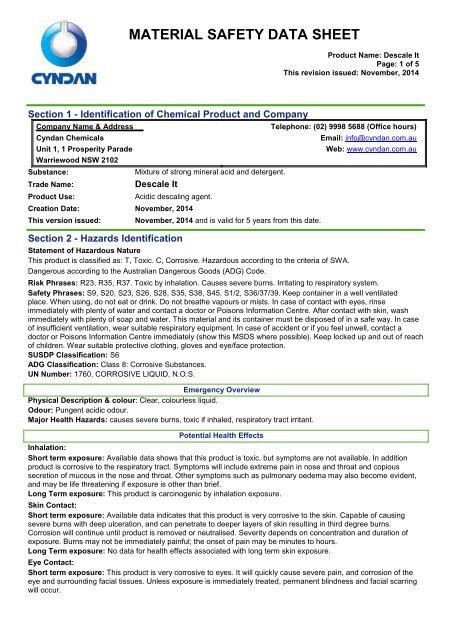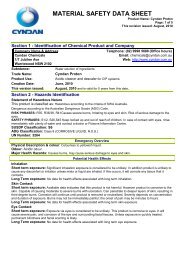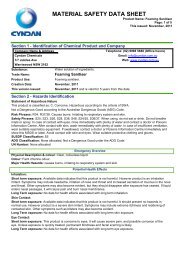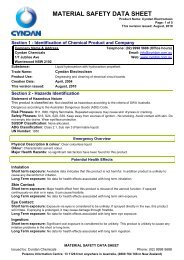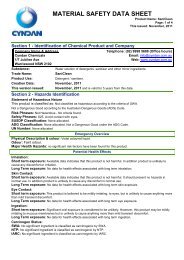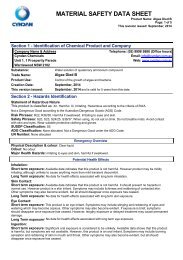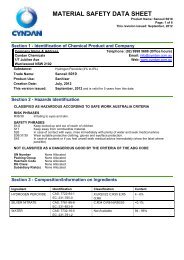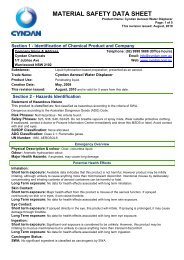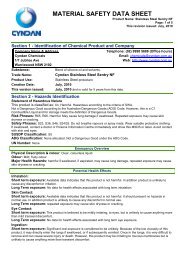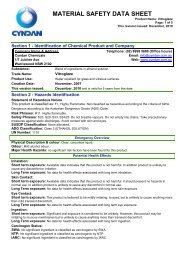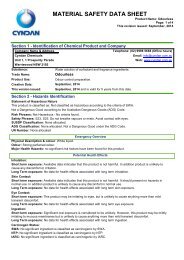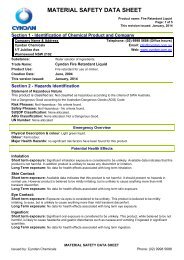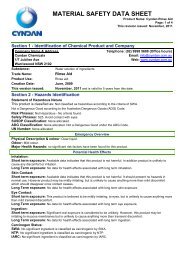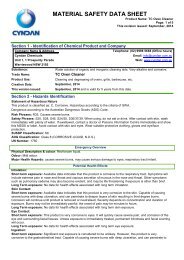Descale It - MSDS - CYNDAN Chemicals
Descale It - MSDS - CYNDAN Chemicals
Descale It - MSDS - CYNDAN Chemicals
You also want an ePaper? Increase the reach of your titles
YUMPU automatically turns print PDFs into web optimized ePapers that Google loves.
MATERIAL SAFETY DATA SHEET<br />
Product Name: <strong>Descale</strong> <strong>It</strong><br />
Page: 1 of 5<br />
This revision issued: November, 2014<br />
Section 1 - Identification of Chemical Product and Company<br />
Company Name & Address<br />
Cyndan <strong>Chemicals</strong><br />
Unit 1, 1 Prosperity Parade<br />
Warriewood NSW 2102<br />
Substance:<br />
Trade Name:<br />
Product Use:<br />
Creation Date:<br />
This version issued:<br />
Mixture of strong mineral acid and detergent.<br />
<strong>Descale</strong> <strong>It</strong><br />
Acidic descaling agent.<br />
November, 2014<br />
November, 2014 and is valid for 5 years from this date.<br />
Telephone: (02) 9998 5688 (Office hours)<br />
Section 2 - Hazards Identification<br />
Statement of Hazardous Nature<br />
This product is classified as: T, Toxic. C, Corrosive. Hazardous according to the criteria of SWA.<br />
Dangerous according to the Australian Dangerous Goods (ADG) Code.<br />
Email: info@cyndan.com.au<br />
Web: www.cyndan.com.au<br />
Risk Phrases: R23, R35, R37. Toxic by inhalation. Causes severe burns. Irritating to respiratory system.<br />
Safety Phrases: S9, S20, S23, S26, S28, S35, S38, S45, S1/2, S36/37/39. Keep container in a well ventilated<br />
place. When using, do not eat or drink. Do not breathe vapours or mists. In case of contact with eyes, rinse<br />
immediately with plenty of water and contact a doctor or Poisons Information Centre. After contact with skin, wash<br />
immediately with plenty of soap and water. This material and its container must be disposed of in a safe way. In case<br />
of insufficient ventilation, wear suitable respiratory equipment. In case of accident or if you feel unwell, contact a<br />
doctor or Poisons Information Centre immediately (show this <strong>MSDS</strong> where possible). Keep locked up and out of reach<br />
of children. Wear suitable protective clothing, gloves and eye/face protection.<br />
SUSDP Classification: S6<br />
ADG Classification: Class 8: Corrosive Substances.<br />
UN Number: 1760, CORROSIVE LIQUID, N.O.S.<br />
Emergency Overview<br />
Physical Description & colour: Clear, colourless liquid.<br />
Odour: Pungent acidic odour.<br />
Major Health Hazards: causes severe burns, toxic if inhaled, respiratory tract irritant.<br />
Potential Health Effects<br />
Inhalation:<br />
Short term exposure: Available data shows that this product is toxic, but symptoms are not available. In addition<br />
product is corrosive to the respiratory tract. Symptoms will include extreme pain in nose and throat and copious<br />
secretion of mucous in the nose and throat. Other symptoms such as pulmonary oedema may also become evident,<br />
and may be life threatening if exposure is other than brief.<br />
Long Term exposure: This product is carcinogenic by inhalation exposure.<br />
Skin Contact:<br />
Short term exposure: Available data indicates that this product is very corrosive to the skin. Capable of causing<br />
severe burns with deep ulceration, and can penetrate to deeper layers of skin resulting in third degree burns.<br />
Corrosion will continue until product is removed or neutralised. Severity depends on concentration and duration of<br />
exposure. Burns may not be immediately painful; the onset of pain may be minutes to hours.<br />
Long Term exposure: No data for health effects associated with long term skin exposure.<br />
Eye Contact:<br />
Short term exposure: This product is very corrosive to eyes. <strong>It</strong> will quickly cause severe pain, and corrosion of the<br />
eye and surrounding facial tissues. Unless exposure is immediately treated, permanent blindness and facial scarring<br />
will occur.
Product Name: <strong>Descale</strong> <strong>It</strong><br />
Page: 2 of 5<br />
This revision issued: November, 2014<br />
Long Term exposure: No data for health effects associated with long term eye exposure.<br />
Ingestion:<br />
Short term exposure: Significant oral exposure is considered to be unlikely. However, this product is very<br />
corrosive to the gastrointestinal tract. Capable of causing severe burns with deep ulceration, and can penetrate to<br />
deeper layers of skin resulting in third degree burns. Corrosion will continue until product is removed or neutralised.<br />
Severity depends on concentration and duration of exposure.<br />
Long Term exposure: No data for health effects associated with long term ingestion.<br />
Carcinogen Status:<br />
SWA: No significant ingredient is classified as carcinogenic by SWA.<br />
NTP: No significant ingredient is classified as carcinogenic by NTP.<br />
IARC: Hydrochloric Acid is Class 3 - unclassifiable as to carcinogenicity to humans.<br />
See the IARC website for further details. A web address has not been provided as addresses frequently change.<br />
Section 3 - Composition/Information on Ingredients<br />
Ingredients CAS No Conc,% TWA (mg/m3) STEL (mg/m3)<br />
Hydrochloric acid 7647-01-0 10-30 7.5 Peak limitation<br />
Lauryl alcohol, phosphated, polyglycol ether 39464-66-9 1-10 not set not set<br />
Water 7732-18-5 to 100 not set not set<br />
This is a commercial product whose exact ratio of components may vary slightly. Minor quantities of other non<br />
hazardous ingredients are also possible.<br />
The SWA TWA exposure value is the average airborne concentration of a particular substance when calculated over a normal 8 hour working day<br />
for a 5 day working week. The STEL (Short Term Exposure Limit) is an exposure value that may be equalled (but should not be exceeded) for no<br />
longer than 15 minutes and should not be repeated more than 4 times per day. There should be at least 60 minutes between successive exposures<br />
at the STEL. The term "peak "is used when the TWA limit, because of the rapid action of the substance, should never be exceeded, even briefly.<br />
Section 4 - First Aid Measures<br />
General Information:<br />
You should call The Poisons Information Centre if you feel that you may have been poisoned, burned or irritated by<br />
this product. The number is 13 1126 from anywhere in Australia (0800 764 766 in New Zealand) and is available at all<br />
times. Have this <strong>MSDS</strong> with you when you call.<br />
Inhalation: If inhalation occurs, contact a Poisons Information Centre. Urgent hospital treatment is likely to be<br />
needed. Remove source of contamination or move victim to fresh air. If breathing is difficult, oxygen may be beneficial<br />
if administered by trained personnel, preferably on a doctor's advice. DO NOT allow victim to move about<br />
unnecessarily. Symptoms of pulmonary oedema can be delayed up to 48 hours after exposure.<br />
Skin Contact: Seek urgent medical attention. Flush contaminated area with lukewarm, gently flowing water for at<br />
least 60 minutes, by the clock. DO NOT INTERRUPT FLUSHING. If necessary, keep emergency vehicle waiting<br />
(show paramedics this <strong>MSDS</strong> and take their advice). Under running water, remove contaminated clothing, shoes and<br />
leather goods (e.g. watchbands, belts).<br />
Eye Contact: Immediately flush the contaminated eye(s) with lukewarm, gently flowing water for at least 60 minutes,<br />
by the clock, while holding the eyelid(s) open. Neutral saline solution may be used as soon as it is available. DO NOT<br />
INTERRUPT FLUSHING. If necessary, keep emergency vehicle waiting (show paramedics this <strong>MSDS</strong> and take their<br />
advice). Take care not to rinse contaminated water into the unaffected eye or onto face. Call a Poisons Information<br />
Centre or a doctor urgently. Take special care if exposed person is wearing contact lenses.<br />
Ingestion: If swallowed, do NOT induce vomiting; rinse mouth thoroughly with water and contact a Poisons<br />
Information Centre. Urgent hospital treatment is likely to be needed. Give activated charcoal if instructed.<br />
Section 5 - Fire Fighting Measures<br />
Fire and Explosion Hazards: There is little risk of an explosion from this product if commercial quantities are<br />
involved in a fire.<br />
Only small quantities of decomposition products are expected from this products at temperatures normally achieved in<br />
a fire. This will only occur after heating to dryness.<br />
Fire decomposition products from this product are likely to be irritating if inhaled.<br />
Extinguishing Media: Not Combustible. Use extinguishing media suited to burning materials. Water fog or fine<br />
spray is the preferred medium for large fires. Try to contain spills, minimise spillage entering drains or water courses.<br />
Fire Fighting: If a significant quantity of this product is involved in a fire, call the fire brigade. There is little danger of<br />
a violent reaction or explosion if significant quantities of this product are involved in a fire. Recommended personal<br />
protective equipment is liquid-tight chemical protective clothing and breathing apparatus.<br />
Flash point:<br />
Does not burn.<br />
MATERIAL SAFETY DATA SHEET<br />
Issued by: Cyndan <strong>Chemicals</strong> Phone: (02) 9998 5688<br />
Poisons Information Centre: 13 1126 from anywhere in Australia, (0800 764 766 in New Zealand)
Product Name: <strong>Descale</strong> <strong>It</strong><br />
Page: 3 of 5<br />
This revision issued: November, 2014<br />
Upper Flammability Limit:<br />
Lower Flammability Limit:<br />
Autoignition temperature:<br />
Flammability Class:<br />
Does not burn.<br />
Does not burn.<br />
Not applicable - does not burn.<br />
Does not burn.<br />
Section 6 - Accidental Release Measures<br />
Accidental release: In the event of a major spill, prevent spillage from entering drains or water courses. Evacuate<br />
the spill area and deny entry to unnecessary and unprotected personnel. Wear full protective chemically resistant<br />
clothing including eye/face protection, gauntlets and self contained breathing apparatus. See below under Personal<br />
Protection regarding Australian Standards relating to personal protective equipment. Suitable materials for protective<br />
clothing include rubber, Nitrile, butyl rubber, neoprene, Teflon. Eye/face protective equipment should comprise as a<br />
minimum, protective goggles. If there is a significant chance that vapours or mists are likely to build up in the cleanup<br />
area, we recommend that you use a respirator. <strong>It</strong> should be fitted with a type B1 cartridge, suitable for acid gases.<br />
Stop leak if safe to do so, and contain spill. Absorb onto sand, vermiculite or other suitable absorbent material. If spill<br />
is too large or if absorbent material is not available, try to create a dike to stop material spreading or going into drains<br />
or waterways. Because of the corrosiveness of this product, special personal care should be taken in any cleanup<br />
operation. Sweep up and shovel or collect recoverable product into labelled containers for recycling or salvage, and<br />
dispose of promptly. Recycle containers wherever possible after careful cleaning. After spills, wash area preventing<br />
runoff from entering drains. If a significant quantity of material enters drains, advise emergency services.<br />
Contaminated area may be neutralised by washing with weak or dilute alkali. Baking soda, washing soda and<br />
limestone are suitable. This material may be suitable for approved landfill. Ensure legality of disposal by consulting<br />
regulations prior to disposal. Thoroughly launder protective clothing before storage or re-use. Advise laundry of nature<br />
of contamination when sending contaminated clothing to laundry.<br />
Section 7 - Handling and Storage<br />
Handling: Keep exposure to this product to a minimum, and minimise the quantities kept in work areas. Check<br />
Section 8 of this <strong>MSDS</strong> for details of personal protective measures, and make sure that those measures are followed.<br />
The measures detailed below under "Storage" should be followed during handling in order to minimise risks to<br />
persons using the product in the workplace. Also, avoid contact or contamination of product with incompatible<br />
materials listed in Section 10.<br />
Storage: This product is a Scheduled Poison. Observe all relevant regulations regarding sale, transport and storage<br />
of this schedule of poison. Store in a cool, well ventilated area. Check containers periodically for corrosion and leaks.<br />
Containers should be kept closed in order to minimise contamination. Make sure that the product does not come into<br />
contact with substances listed under "Incompatibilities" in Section 10. If you keep more than 2500kg or L of<br />
Dangerous Goods of Packaging Group II, you may be required to license the premises or notify your Dangerous<br />
Goods authority. If you have any doubts, we suggest you contact your Dangerous Goods authority in order to clarify<br />
your obligations. Check packaging - there may be further storage instructions on the label.<br />
Section 8 - Exposure Controls and Personal Protection<br />
The following Australian Standards will provide general advice regarding safety clothing and equipment:<br />
Respiratory equipment: AS/NZS 1715, Protective Gloves: AS 2161, Industrial Clothing: AS2919, Industrial Eye<br />
Protection: AS1336 and AS/NZS 1337, Occupational Protective Footwear: AS/NZS2210.<br />
SWA Exposure limits<br />
TWA (mg/m3)<br />
STEL (mg/m3)<br />
Hydrochloric acid<br />
7.5<br />
Peak limitation<br />
No special equipment is usually needed when occasionally handling small quantities. The following instructions are<br />
for bulk handling or where regular exposure in an occupational setting occurs without proper containment systems.<br />
Ventilation: This product should only be used in a well ventilated area. If natural ventilation is inadequate, use of a<br />
fan is suggested.<br />
Eye Protection: Your eyes must be completely protected from this product by splash resistant goggles with face<br />
shield. All surrounding skin areas must be covered. Emergency eye wash facilities must also be available in an area<br />
close to where this product is being used.<br />
Skin Protection: Because of the dangerous nature of this product, make sure that all skin areas are completely<br />
covered by impermeable gloves, overalls, hair covering, apron and face shield. See below for suitable material types.<br />
Protective Material Types: We suggest that protective clothing be made from the following materials: rubber,<br />
nitrile, butyl rubber, neoprene, Teflon.<br />
Respirator: Usually, no respirator is necessary when using this product. However, if you have any doubts consult<br />
the Australian Standard mentioned above.<br />
Safety deluge showers should, if practical, be provided near to where this product is being used.<br />
MATERIAL SAFETY DATA SHEET<br />
Issued by: Cyndan <strong>Chemicals</strong> Phone: (02) 9998 5688<br />
Poisons Information Centre: 13 1126 from anywhere in Australia, (0800 764 766 in New Zealand)
Product Name: <strong>Descale</strong> <strong>It</strong><br />
Page: 4 of 5<br />
This revision issued: November, 2014<br />
Section 9 - Physical and Chemical Properties:<br />
Physical Description & colour:<br />
Odour:<br />
Boiling Point:<br />
Freezing/Melting Point:<br />
Volatiles:<br />
Vapour Pressure:<br />
Vapour Density:<br />
Specific Gravity:<br />
Water Solubility:<br />
pH:<br />
Volatility:<br />
Odour Threshold:<br />
Evaporation Rate:<br />
Coeff Oil/water distribution:<br />
Autoignition temp:<br />
Section 10 - Stability and Reactivity<br />
Clear, colourless liquid.<br />
Pungent acidic odour.<br />
Approximately 100°C at 100kPa.<br />
Approximately 0°C.<br />
Water component.<br />
2.37 kPa at 20°C (water vapour pressure).<br />
No data.<br />
>1<br />
Completely soluble in water.<br />
Extremely acidic.<br />
No data.<br />
No data.<br />
No data.<br />
No data<br />
Not applicable - does not burn.<br />
Reactivity: Most strong acids react with inorganic and organic bases such as amines to form salts. They also react<br />
with many metals liberating hydrogen gas. These reactions are often rapid and sometimes liberate much heat. They<br />
can also decompose many organic materials such as esters, in a reaction called hydrolysis.<br />
Conditions to Avoid: This product should be kept in a cool place, preferably below 30°C. Keep containers tightly<br />
closed. Containers should be kept dry. Keep containers and surrounding areas well ventilated.<br />
Incompatibilities: bases, zinc, tin, aluminium and their alloys, other substances reactive with strongly acidic<br />
reagents.<br />
Fire Decomposition: Only small quantities of decomposition products are expected from this products at<br />
temperatures normally achieved in a fire. This will only occur after heating to dryness. Carbon dioxide, and if<br />
combustion is incomplete, carbon monoxide and smoke. Oxides of phosphorus and other phosphorus compounds.<br />
Hydrogen chloride gas, other compounds of chlorine. Water. Carbon monoxide poisoning produces headache,<br />
weakness, nausea, dizziness, confusion, dimness of vision, disturbance of judgment, and unconsciousness followed<br />
by coma and death.<br />
Polymerisation: This product will not undergo polymerisation reactions.<br />
Section 11 - Toxicological Information<br />
Local Effects:<br />
Target Organs:<br />
Ingredient<br />
Hydrochloric Acid<br />
There is no data to hand indicating any particular target organs.<br />
Classification of Hazardous Ingredients<br />
Risk Phrases<br />
Conc>=5%:T; R23, R35<br />
Section 12 - Ecological Information<br />
This product is unlikely to adversely effect the environment in the long term. Salts, acids and bases are typically<br />
diluted and neutralised when released to the environment in small quantities. This will however kill aquatic organisms<br />
because of its extreme pH until diluted or neutralised.<br />
Section 13 - Disposal Considerations<br />
Disposal: This product may be recycled if unused, or if it has not been contaminated so as to make it unsuitable for<br />
its intended use. If it has been contaminated, it may be possible to separate the contamination in some way. Only if<br />
neither of these options is suitable, consider landfill, but we recommend that it be neutralised in a controlled manner<br />
before disposal.<br />
Section 14 - Transport Information<br />
ADG Code: 1760, CORROSIVE LIQUID, N.O.S.<br />
Hazchem Code: 2X<br />
Special Provisions: 274<br />
Limited quantities: ADG 7 specifies a Limited Quantity value of 1 L for this class of product.<br />
MATERIAL SAFETY DATA SHEET<br />
Issued by: Cyndan <strong>Chemicals</strong> Phone: (02) 9998 5688<br />
Poisons Information Centre: 13 1126 from anywhere in Australia, (0800 764 766 in New Zealand)
Product Name: <strong>Descale</strong> <strong>It</strong><br />
Page: 5 of 5<br />
This revision issued: November, 2014<br />
Dangerous Goods Class: Class 8: Corrosive Substances.<br />
Packaging Group: II<br />
Packaging Method: P001, IBC02<br />
Class 8 Corrosive Substances shall not be loaded in the same vehicle or packed in the same freight container with<br />
Classes 1 (Explosives), 4.3 (Dangerous When Wet Substances), 5.1 (Oxidising Agents), 5.2 (Organic Peroxides), 6<br />
(Toxic Substances where the Toxic Substances are cyanides and the Corrosives are acids), 7 (Radioactive<br />
Substances), Foodstuffs and foodstuff empties. They may however be loaded in the same vehicle or packed in the<br />
same freight container with Classes 2.1 (Flammable Gases), 2.2 (Non-Flammable, Non-Toxic Gases), 2.3 (Poisonous<br />
Gases), 3 (Flammable liquids), 4.1 (Flammable Solids), 4.2 (Spontaneously Combustible Substances), 6 (Toxic<br />
Substances except where the Toxic Substances are cyanides and the Corrosives are acids) and 9 (Miscellaneous<br />
Dangerous Goods).<br />
Section 15 - Regulatory Information<br />
AICS: All of the significant ingredients in this formulation are compliant with NICNAS regulations.<br />
The following ingredient: Hydrochloric acid , is mentioned in the SUSDP.<br />
Section 16 - Other Information<br />
Acronyms:<br />
ADG Code<br />
AICS<br />
SWA<br />
CAS number<br />
Hazchem Code<br />
IARC<br />
NOS<br />
NTP<br />
R-Phrase<br />
SUSDP<br />
UN Number<br />
This <strong>MSDS</strong> contains only safety-related information. For other data see product literature.<br />
Australian Code for the Transport of Dangerous Goods by Road and Rail (7th edition)<br />
Australian Inventory of Chemical Substances<br />
Safe Work Australia, formerly ASCC and NOHSC<br />
Chemical Abstracts Service Registry Number<br />
Emergency action code of numbers and letters that provide information to emergency<br />
services especially firefighters<br />
International Agency for Research on Cancer<br />
Not otherwise specified<br />
National Toxicology Program (USA)<br />
Risk Phrase<br />
Standard for the Uniform Scheduling of Drugs & Poisons<br />
United Nations Number<br />
TELEPHONE (Business hours): (02) 9998 5688 Fax: (02) 9999 2086<br />
National Poisons Information Centre:<br />
Dial 13 1126 (from anywhere in Australia)<br />
THIS <strong>MSDS</strong> SUMMARISES OUR BEST KNOWLEDGE OF THE HEALTH AND SAFETY HAZARD INFORMATION OF THE PRODUCT AND<br />
HOW TO SAFELY HANDLE AND USE THE PRODUCT IN THE WORKPLACE. EACH USER SHOULD READ THIS <strong>MSDS</strong> AND CONSIDER THE<br />
INFORMATION IN THE CONTEXT OF HOW THE PRODUCT WILL BE HANDLED AND USED IN THE WORKPLACE INCLUDING IN<br />
CONJUNCTION WITH OTHER PRODUCTS. IF CLARIFICATION OR FURTHER INFORMATION IS NEEDED TO ENSURE THAT AN<br />
APPROPRIATE RISK ASSESSMENT CAN BE MADE, THE USER SHOULD CONTACT THIS COMPANY. THE RESPONSIBILITY FOR<br />
PRODUCTS SOLD IS SUBJECT TO OUR STANDARD TERMS AND CONDITIONS, A COPY OF WHICH IS SENT TO OUR CUSTOMERS AND<br />
IS ALSO AVAILABLE ON REQUEST.<br />
Please read all labels carefully before using product.<br />
This <strong>MSDS</strong> is prepared in accord with the SWA document “National Code of Practice for the Preparation of<br />
Material Safety Data Sheets” 2nd Edition [NOHSC:2011(2003)]<br />
MATERIAL SAFETY DATA SHEET<br />
Issued by: Cyndan <strong>Chemicals</strong> Phone: (02) 9998 5688<br />
Poisons Information Centre: 13 1126 from anywhere in Australia, (0800 764 766 in New Zealand)


